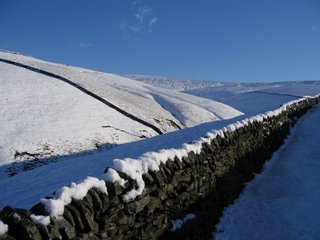Monday, January 22, 2007
Last week I presented preliminary findings from our 'enquiry-based learning' project for the first year induction fieldtrip in Keswick. The presentation was done with colleagues, Sara MacKian, Chris Perkins and Fiona Smyth.
Details:
Dodge M, Jayne M, MacKian S, Perkins C, Smyth F, 2006 "From the very first day: development new senses of place through EBL", presented at the Centre for Excellence in Enquiry-Based Learning, University of Manchester, 17th January. [slides are online]
Details:
Dodge M, Jayne M, MacKian S, Perkins C, Smyth F, 2006 "From the very first day: development new senses of place through EBL", presented at the Centre for Excellence in Enquiry-Based Learning, University of Manchester, 17th January. [slides are online]
Our paper on the 'ethics of forgetting' will be coming out in a special issue of Environment and Planning B on Space, Sociality and Pervasive Computing. It looks like it will be a useful collection. Hopefully, it should be published at some point this year.
Papers in the special issue are :
Papers in the special issue are :
- Mapping DigiPlace: Geo-coded Internet Data and the Representation of Place (Zook)
- Outlines of a world coming into existence : Pervasive computing and the ethics of forgetting (Dodge & Kitchin)
- Understanding and representing the social prospects of hybrid urban spaces (Paay)
- New Media Urbanism: Grounding ambient information technology (McCullough)
- Seoul: Birth of a Broadband Metropolis (Townsend)
- The Infrastructure of Experience and the Experience of Infrastructure: Meaning and Structure in Everyday Encounters with Space (Dourish)
Saturday, January 20, 2007
I have been writing a couple of entries for the massive International Encyclopedia of Human Geography with Matt Zook. They have been quite delayed for various reasons and we just submitted our draft entry for 'internet-based measurement'. It will be interesting to see what the editor makes of it. The synopsis is below. Now, just have got to finish off the entry on 'mapping cyberspace'.
--
Internet-based measurement is a set of methods applied to quantitatively describe the structure, workload and use of the Internet. They provide a practical means of doing a kind of virtual ‘fieldwork’ on the Internet using online tools and network monitoring techniques to gather fine scale primary data. Internet-based measurement as a methodology for human geography is important because it (1) provides insight to the underlying structural processes of the Internet and Internet based activities; (2) allows users to explore and analyze the Internet for themselves; and (3) allows researchers to aggregate data spread across multiple websites to analyze offline phenomenon. After outlining the five distinct kinds of geographical locations associated with an Internet based resource (lexical, hardware, production, ownership and use) this chapter outlines a range of tools and techniques for exploring these geographies. These include IP address geo-coding, domain name whois lookups, website rankings, ping, and traceroute. These tools can provide an understanding of the topological structures and geographies of the Internet, and allows users to construct information first-hand and critically question network operations directly.
--
Internet-based measurement is a set of methods applied to quantitatively describe the structure, workload and use of the Internet. They provide a practical means of doing a kind of virtual ‘fieldwork’ on the Internet using online tools and network monitoring techniques to gather fine scale primary data. Internet-based measurement as a methodology for human geography is important because it (1) provides insight to the underlying structural processes of the Internet and Internet based activities; (2) allows users to explore and analyze the Internet for themselves; and (3) allows researchers to aggregate data spread across multiple websites to analyze offline phenomenon. After outlining the five distinct kinds of geographical locations associated with an Internet based resource (lexical, hardware, production, ownership and use) this chapter outlines a range of tools and techniques for exploring these geographies. These include IP address geo-coding, domain name whois lookups, website rankings, ping, and traceroute. These tools can provide an understanding of the topological structures and geographies of the Internet, and allows users to construct information first-hand and critically question network operations directly.
Thursday, January 11, 2007
The automatic management of drivers and driving spaces
Our paper is officially published in Geoforum in March 2007. (A local copy is available here.)
Abstract
In this paper, we examine the development and implementation of new technical systems designed to more effectively manage and produce driving, drivers and driving spaces. These new systems change the governmentality of automobilities by altering the relationship between driver, vehicle and transport infrastructure and produce new subjects and spaces. They do this principally through the process of automation, creating a system of regulation that we term ‘automated management’. Automated management consists of two interlocking sets of regulatory technologies: automated surveillance that seeks to enforce more effective (self)disciplining and capture systems that actively reshape activity. We argue that these work together to alter the automobilities landscape creating new sociospatial arrangements with respect to access, movement, flow, and behaviour. Some of these arrangements are benign and empowering to individuals, others enhance the power of state and corporations. We illustrate our argument with examples predominately drawn from the UK, though the technologies we discuss are increasingly being developed and implemented throughout Western countries
and beyond.
© 2006 Elsevier Ltd. All rights reserved.
Keywords: Automobile; Software; Surveillance; Space; Transport
Our paper is officially published in Geoforum in March 2007. (A local copy is available here.)
Abstract
In this paper, we examine the development and implementation of new technical systems designed to more effectively manage and produce driving, drivers and driving spaces. These new systems change the governmentality of automobilities by altering the relationship between driver, vehicle and transport infrastructure and produce new subjects and spaces. They do this principally through the process of automation, creating a system of regulation that we term ‘automated management’. Automated management consists of two interlocking sets of regulatory technologies: automated surveillance that seeks to enforce more effective (self)disciplining and capture systems that actively reshape activity. We argue that these work together to alter the automobilities landscape creating new sociospatial arrangements with respect to access, movement, flow, and behaviour. Some of these arrangements are benign and empowering to individuals, others enhance the power of state and corporations. We illustrate our argument with examples predominately drawn from the UK, though the technologies we discuss are increasingly being developed and implemented throughout Western countries
and beyond.
© 2006 Elsevier Ltd. All rights reserved.
Keywords: Automobile; Software; Surveillance; Space; Transport
 Cyber Badger Research Blog
Cyber Badger Research Blog




